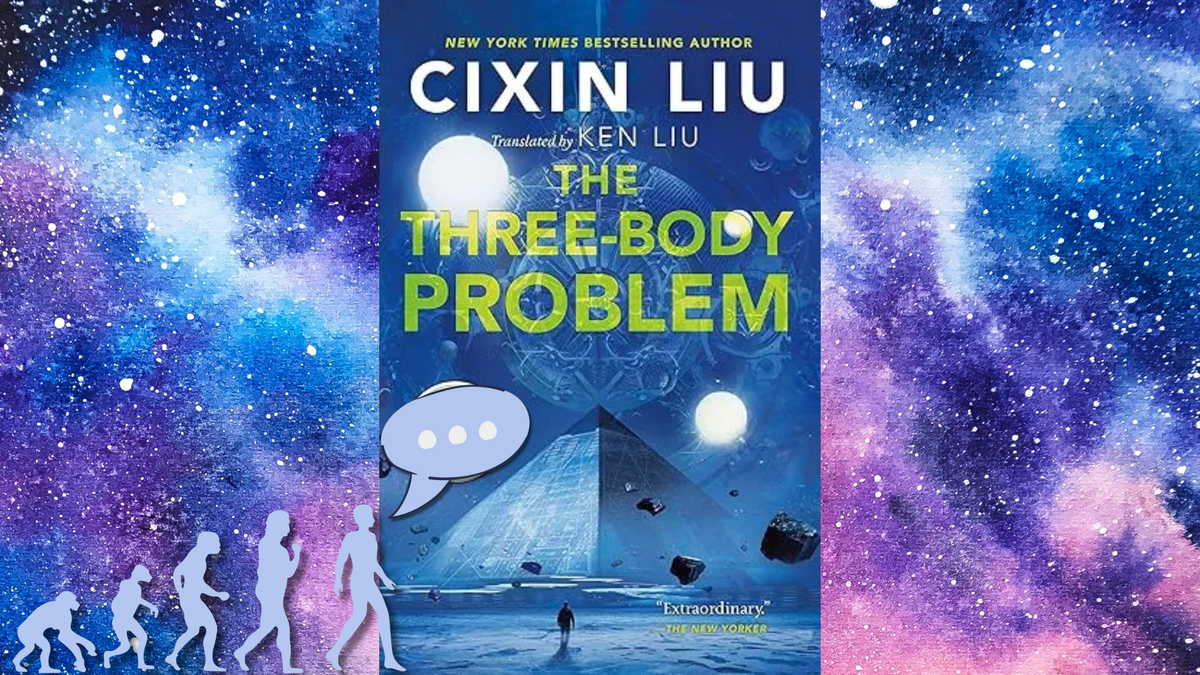What alien languages can teach us about human language: The linguistics of The Three-Body Problem
Imagine if every word you thought could be heard by everyone around you. In this world, thinking would be the same as communicating. What would language—and society—be like?

Contents
- How the Trisolaran language works
- The design features of language
- What we can learn from Trisolaran language
Imagine if every word you thought could be heard by everyone around you. In this world, thinking would be the same as communicating. What would language—and society—be like?
This is exactly the thought experiment that Cixin Liu explores as a component of his brilliant Three-Body Problem trilogy (officially titled Remembrance of Earth’s Past, and recently adapted as a Netflix series).

Prefer a video version of this article? Watch here!
How the Trisolaran language works
Early in the series, humans make long-range contact with an alien race they name the Trisolarans, after their trinary star system. (In the TV show they are called the San Ti, from the Chinese 三体人 Sān Tǐ Rén ‘Three Body People’.) After establishing instantaneous communication using quantum entanglement, the two civilizations began to learn about each other, until one feature of human communication gives the Trisolarans cause for grave concern. In this scene early in the series' second novel, Mike Evans, a representative of the one organization in contact with the Trisolarans, talks with them via instantaneous long-range communications:
Trisolarans: “Think” and “say.” We’ve just learned, to our surprise, that they are not, in fact, synonyms.
Mike Evans: They are not synonyms at all.
Trisolarans: In our understanding, they ought to be. “Think” means using thought organs to conduct mental activity. “Say” means communicating the content of thoughts to a counterpart. The latter, in your world, is accomplished through the modulation of vibrations in the air produced by the vocal cords. Are these definitions correct?
Evans: They are. But doesn’t this demonstrate that “think” and “say” aren’t synonyms?
Trisolarans: In our understanding, this shows that they are synonyms.
[…]
Evans: [W]hat are your organs of communication?
Trisolarans: We do not have organs of communication. Our brains can display our thoughts to the outside world, thereby achieving communication.
Evans: Display thoughts? How is that done?
Trisolarans: The thoughts in our brains emit electromagnetic waves on all frequencies, including what is visible light to us. They can be displayed at a significant distance.
Evans: So that means to you, thinking is speaking?
Trisolarans: Hence they are synonyms.
[…]
Evans: Your thoughts are completely exposed to the outside world. You can’t hide.
Trisolarans: How can thoughts hide? Your ideas are confusing.
[…]
Evans: [W]hen you communicate face-to-face, everything you communicate is true. It’s impossible for you to cheat or lie, so you can’t pursue complicated strategic thinking.
Trisolarans: We can communicate over significant distances, not just face-to-face. The words “cheating” and “lying” are another two that we have had a hard time understanding.
Evans: What sort of a society is it when thought is completely transparent? What sort of culture does it produce? What sort of politics? No scheming, no pretending.
Trisolarans: What are “scheming” and “pretending?”
[Evans says nothing.]
Trisolarans: Human communication organs are but an evolutionary deficiency, a necessary compensation for the fact that your brains can’t emit strong thought waves. This is one of your biological weaknesses. Direct display of thought is a superior, more efficient form of communication.
Evans: A deficiency? A weakness? No[,] you are wrong. This time you are totally wrong.
[The Trisolarans think for a bit.]
Trisolarans: You are correct. Looking back at [the histories I’ve read], I understand them a little better.
Evans: [T]here’s a long road to travel before you arrive at a true understanding of human matters. I’m almost afraid that you’ll never be able to.
Trisolarans: Indeed, they are complicated. All I know now is why I didn’t understand them before. You are right. […] I am afraid of you.
(The Dark Forest, pp. 17–24)
The Trisolarans, now terrified of humanity’s ability to lie, proceed to cut off all communication with Earth and prepare for war.
The design features of language
So what would the Trisolaran language be like? We’ve already seen one consequence—the inability to lie. Yet linguists have long considered prevarication (lying or deception) to be one of the fundamental design features of language, one of a cluster of properties of human language that—taken together—distinguish it from other forms of animal communication.
Here it's important to make a distinction between signals that are communicative (that is, intentional), and signals that are merely informative (conveying information, whether intentionally or unintentionally). Animals are replete with many types of informative signals, such as the way that large antlers signal that an elk is healthy. Informative signals in the animal kingdom are generally honest because such signals are costly:
Elks cannot lie with their antlers for the simple reason that an elk that is not actually big and strong will be incapable of developing and wearing tines that are that large. The lie would give itself away. The same applies to the calls of the blackcock or the song of the nightingale—singing and calling for hours is hard work and a male has to be in peak form to be able to do it. (Johansson 2021: 35)
If those signals were easy to imitate, they would be meaningless as an indicator of physical strength. Some species do nonetheless evolve deceptive signals, like the way the harmless hoverfly evolved the same striped abdomen as the more dangerous wasp, but these signals are only successful in their deception so long as they do not become commonplace among other species. They also cannot be considered intentional.
When it comes to intentional communicative signals performed by animals, many species seem to exhibit some evidence of occasional deception (though it is always extremely difficult to tell whether these apparent "deceptive" behaviors are in fact intentional or merely learned behavior). For instance, low-ranking female baboons appear to attempt to hide new food sources they discover in the presence of high-ranking female baboons, but high-ranking baboons don't bother with such antics (Cheney & Seyfarth 2007: 153). Likewise, when alpha male bonobos mate with low status female bonobos, they generally keep quiet, as opposed to when they mate with high status females (Johansson 2021: 34). In both cases, it seems these simians are intentionally concealing information from their troop.
Yet human language is unique in that talk is cheap and we can lie at will. Deception in the rest of the animal kingdom is a marginal behavior at best, but human behavior is rife with it. But if we can manipulate truth in language so easily, why hasn't language become meaningless? Why doesn't the whole human communicative system just fall apart?
Conversation is based on certain principles of cooperation known as Gricean maxims. Though these maxims can be subverted or even ignored, we generally follow them when we interact with each other. Ironically, it’s this very foundation of social trust that makes lying possible. Without such social cooperation, we’d have to assume all communication was a potential lie, and therefore all talk would be meaningless. It follows that humans must have already had a culture of social cooperation before language evolved.
In one respect, the Trisolaran language is like those elk antlers. The signal cannot be manipulated to deceive. But in terms of evolutionary costliness, Trisolaran communication is like human language—cheap and easy to produce. Fittingly, when humanity first contacts the Trisolarans, Trisolaran society is extremely totalitarian. Social cooperation is not necessary for their form of communication to work, so their society managed to evolve without it. It is only after their exposure to human culture with our ability to lie that the Trisolarans enter a cultural golden age and free themselves of their totalitarian shackles.
The Trisolaran language challenges linguistic design principles in other ways as well. Humans can generally hear their own speech or see their own signing, and have the ability to control or modify it. But while Trisolarans can perceive their own thought waves, they don’t control them to the same extent that humans control what they say or sign. The ability to perceive and control one’s own language output is a design feature known as complete feedback. Trisolarans seem to exhibit only partial feedback.
One respect in which Trisolaran biology differs drastically from human biology is that Trisolarans reproduce by first physically merging together, and then separating into three to five offspring, each of whom have some of their parents’ memories and personality traits. As such, Trisolarans have no childhood, and presumably never have to learn their own language. (I can only imagine how heated and complicated the debate between linguistic nativism vs. functionalism is on the planet Trisolaris—and it’s already pretty heated here on Earth! Is the Trisolaran language innate or simply remembered?) Trisolarans lack one of the key mechanisms by which language change happens on Earth—cultural transmission, another design feature of language. Since every child is exposed to different sets of linguistic input in childhood, every child learns a slightly different grammar of the same language, with slightly different pronunciations. As they learn, children often reanalyze expressions in new ways. This process constitutes the primary engine by which languages change over time. On Trisolaris, this process doesn’t happen. (So all those grammar pedants who rail against language change and constantly complain about how the kids are ruining language would love Trisolaris.)
Instead of child language acquisition, Trisolarans presumably just acquire a blend of their two parents’ idiolects (personal dialects), avoiding much of the intergenerational variation we see in human language.
However, child language acquisition is not the only mechanism by which language changes. Though our idiolect generally stays fairly stable after puberty, the way we speak does continue to change over the course of our lifetime. Much of this change is driven by social factors. Certain ways of speaking are associated with different social groups or categories, but people’s social categories change frequently throughout their lives. Assuming that the same holds true of Trisolaran society, it seems reasonable to assume that the Trisolaran language would still change—albeit drastically more slowly—even without child language acquisition. Perhaps the Trisolaran language is like Icelandic—still comprehensible even after a thousand years.

What we can learn from the Trisolaran language
In the end, even though the discovery of a Trisolaran language would force us to relegate certain features we once thought were essential to language, such a deception-free language might not be as fundamentally different from human language as one would originally think.
Human language is very much shaped by its mediums—the physiology of the human vocal tract, the properties of sound propagating through air, our ability to perceive and process those sounds, the processing capabilities of the human brain, and even the medium of time. Over the course of the two million years that the homo genus has been evolving, human language has become highly optimized for these mediums, just as humans themselves have become highly optimized for using language, in a coevolutionary feedback loop. If our hearing range were slightly more restricted, our languages probably wouldn’t contain the sibilant sounds /s, z, ʃ, ʒ, ɕ, ʂ, ʑ, ʐ/. If our working memory were slightly smaller, we might use fewer pronouns, demonstratives, or relative clauses (Kibrik 2011: 53). If Earth had a warmer climate, our languages might have more sonorant sounds. If all spoken languages were tonal, it’s likely our entire species would have evolved perfect pitch. (The incidence of perfect pitch is drastically higher among speakers of Mandarin than English, for example.) Humans are capable of making miniscule adjustments to the frequency of vibration of their vocal folds within microseconds, a degree of incredibly fine motor skill that is lacking in the vocal tracts of other primates. Language is so intertwined with the evolution of our species that it’s difficult to imagine what non-human languages might be like. Yet Cixin Liu’s fantastic Three-Body Problem trilogy lets us explore another way language might manifest, and in doing so helps us better understand what it is that makes human language unique, and how we should define language in the first place.
Get your own copy of The Three-Body Problem here.

🙏 Credits
This issue of the Linguistic Discovery newsletter was edited by Amy Treber. If you’re looking for professional copyediting services, email Amy at amytreberedits@gmail.com.
The final responsibility for any mistakes or omissions is of course still wholly my own.
📚 Recommended Reading





📑 References
- Cheney, Dorothy L. & Robert M. Seyfarth. 2007. Baboon metaphysics: The evolution of a social mind. University of Chicago Press.
- Johansson, Sverker. 2021. The dawn of language: How we came to talk. Quercus Publishing.
- Kibrik, Andrej A. 2011. Reference in discourse (Oxford Studies in Typology & Linguistic Theory). Oxford University Press.
If you’d like to support Linguistic Discovery, purchasing through these links is a great way to do so! I greatly appreciate your support!
Check out my entire Amazon storefront here.





